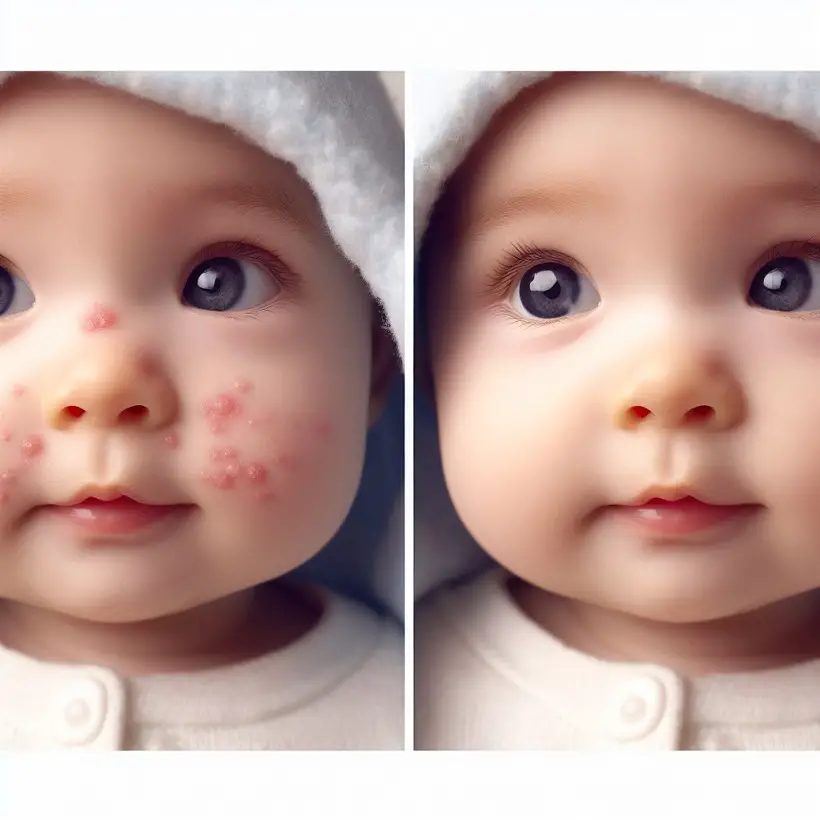As a parent, you may have heard that teething can cause ear infections in your little one. However, the connection between the two is still a topic of debate. In this section, we’ll explore the potential link between teething and ear infections, and how it can impact your baby’s health and development.
Firstly, let’s define what teething and ear infections are. Teething is the process of an infant’s first teeth breaking through the gums, which usually begins around six months of age. Ear infections, on the other hand, are caused by a bacterial or viral infection in the middle ear and can occur at any age, but are most common in babies and young children.
So, can teething cause ear infections? While there is no direct evidence to support this claim, some healthcare professionals believe that the increased drooling and gum swelling during teething can lead to an increase in bacteria and germs around the mouth, which may then travel to the ear and cause an infection. Additionally, the pressure and pain from teething can lead to ear pulling or rubbing, which can introduce bacteria into the ear canal.
It’s important to note that not all ear infections are caused by teething, and there may be other underlying factors at play. That said, being aware of the potential link between the two can help you recognize the symptoms and seek appropriate medical advice.
Key Takeaways:
- Teething and ear infections are common in babies and young children.
- While there is no direct evidence to support the link between teething and ear infections, some healthcare professionals believe that teething can increase the risk of ear infections.
- Increased drooling, gum swelling, and ear pulling during teething may lead to an increase in bacteria and germs around the mouth, which can travel to the ear and cause an infection.

What Are the Symptoms of Teething?
Teething is an important milestone in your baby’s development, but it can also be a challenging time for both you and your little one. As your baby’s teeth begin to emerge, you may notice some changes in their behavior and overall well-being. Here are some common symptoms of teething to watch out for:
- Fussiness: Your baby may be more irritable or cranky than usual.
- Drooling: Excessive drooling is a common sign of teething and can lead to skin irritation around the chin and mouth.
- Gum discomfort: Your baby may try to relieve the discomfort by chewing on objects or rubbing their gums.
- Changes in appetite: Your baby may eat less than usual or refuse to eat altogether due to the discomfort.
- Sleep disturbances: Teething can disrupt your baby’s sleep patterns and lead to more frequent waking up during the night.
These symptoms can begin as early as 3 to 4 months of age and may persist until your baby’s primary teeth have fully emerged. It’s important to note that not all babies experience teething symptoms, and some may experience them differently than others. If you notice any unusual symptoms or changes in your baby’s behavior, it’s always a good idea to consult with your pediatrician.
Teething or Ear Infection?
Teething symptoms can sometimes be mistaken for other health issues, such as ear infections. While teething can increase your baby’s risk of ear infections, it’s important to know the difference between the two. You can differentiate between teething and an ear infection by looking out for additional symptoms like:
- Fever: A fever is not a common symptom of teething, but it can indicate an infection.
- Ear tugging or rubbing: Your baby may tug on or rub their ears if they have an infection.
- Ear drainage: If you notice any discharge or fluid coming from your baby’s ear, it may be an infection.
If you suspect that your baby has an ear infection, it’s important to seek medical attention as soon as possible.
The Basics of Ear Infections in Babies
If your baby has ever experienced an ear infection, you’re not alone. It’s one of the most common illnesses in infants, and understanding the basics of ear infections can help you identify if your baby is at risk.
So, what exactly is an ear infection? It’s an inflammation or infection of the middle ear, which is located behind the eardrum. The middle ear contains tiny, delicate bones that vibrate in response to sound waves and transmit sound to the inner ear.
When the middle ear becomes infected or inflamed, it can cause discomfort or pain, and in some cases, lead to more severe complications.
The Types of Ear Infections
There are three main types of ear infections in babies:
- Acute otitis media (AOM): This is the most common type of ear infection in infants and is typically caused by bacteria. Symptoms of AOM can include ear pain, fever, and irritability.
- Otitis media with effusion (OME): This type of ear infection occurs when fluid builds up in the middle ear without being infected. It can cause muffled hearing and may not present any other symptoms.
- Chronic otitis media with effusion (COME): This occurs when fluid continues to accumulate in the middle ear for an extended period, leading to hearing loss and potential developmental delays.
The Causes of Ear Infections
Ear infections can be caused by a variety of factors, including:
- Bacterial or viral infections
- Exposure to secondhand smoke
- Daycare attendance
- Seasonal changes or allergies
- Problems with the structure of the ear
These factors can all contribute to inflammation or fluid buildup in the middle ear, increasing the risk of ear infections.
The Risk Factors for Ear Infections
Some babies may be at a higher risk of developing ear infections due to certain risk factors, including:
- Age: Infants and young children are more susceptible to ear infections because their immune systems are still developing, and their Eustachian tubes (the tubes that connect the middle ear to the back of the throat) are shorter and more horizontal than an adult’s, making it easier for fluid and bacteria to accumulate.
- Family history: If a parent or sibling has a history of ear infections, the baby may be more likely to develop them as well.
- Seasonal allergies: Allergies can cause inflammation in the nasal passages, leading to increased risk of ear infections.
- Passive smoking: Exposure to secondhand smoke can irritate the baby’s respiratory tract, increasing the risk of infections.
Understanding the basics of ear infections can help you monitor your baby’s health and identify potential risk factors. If you suspect your baby may have an ear infection, it’s important to consult with a healthcare professional for proper diagnosis and treatment.
Is There a Link Between Teething and Ear Infections?
As a parent, you may have heard that teething can cause ear infections in babies. While there is ongoing debate about the direct link between the two, several studies suggest that teething may increase the risk of ear infections.
Teething can cause inflammation and pain in the gums and teeth, which can also affect the Eustachian tube. The Eustachian tube connects the middle ear to the back of the throat, helping to regulate air pressure. When the Eustachian tube is blocked or swollen, fluid can build up in the middle ear, leading to an ear infection.
According to medical experts, teething may not directly cause ear infections, but it can contribute to the development of them. Therefore, it’s crucial to keep an eye on your child’s ear health during the teething process, especially if they display symptoms of an ear infection.
Expert Medical Advice on Teething and Ear Infections
“There is no direct evidence that teething causes ear infections, but there is a significant correlation between the two. Teething can result in gum irritation, and if the tooth is not coming in correctly, it can cause inflammation that can impact the Eustachian tube.”
– Dr. Alanna Levine, Pediatrician
Overall, it’s essential to monitor your child’s ear health during the teething process and seek medical advice if needed. By staying informed and proactive, you can help prevent and manage ear infections and promote your baby’s overall health and well-being.
Managing Teething Discomfort and Ear Health
Teething can cause various discomforts for your baby, such as gum swelling and irritability. But did you know that teething can also affect your child’s ear health? Here are some strategies to help you manage both teething discomfort and ear health during this critical infant development phase.
Teething Remedies
There are several remedies that can ease your baby’s teething symptoms. For instance:
- Teething toys: These can provide some relief for your child’s sore gums. Look for toys that are soft and chewable.
- Teething rings: These can be chilled in the fridge (not freezer!) before giving them to your baby as the cold can help soothe the gums.
- Clean and gently massage your baby’s gums: You can use a clean finger, wet gauze or a soft washcloth to massage your baby’s gums.
Earache Remedies
If your baby is experiencing earaches, you can try the following remedies:
- Warm compresses: Placing a warm, damp cloth against your baby’s ear can help alleviate pain and discomfort.
- Pain relief medication: Over-the-counter pain medication like acetaminophen or ibuprofen can help reduce pain and fever. Consult with your doctor before administering any medication to your child.
- Vapor rubs: Rubbing a small amount of menthol or eucalyptus vapor rub on your baby’s chest can help clear the nasal passages and reduce ear pressure.
Preventive Measures
Prevention is always better than cure. Take these steps to reduce the likelihood of ear infections during teething:
- Maintain good oral hygiene: Wipe your baby’s gums with a soft, clean cloth after feeding. Once your baby’s teeth appear, use a soft-bristled toothbrush and water to gently brush their teeth and gums.
- Minimize pacifier use: If your child uses a pacifier, try to limit its use and ensure it’s clean.
- Avoid exposing your baby to secondhand smoke: Smoking can increase the risk of ear infections.
By following these strategies, you can help your baby handle teething discomfort and promote good ear health. Remember to consult with a healthcare professional if you have any concerns about your child’s health.
Recognizing the Signs of an Ear Infection
It’s crucial to pay attention to your baby’s symptoms and look out for signs of an ear infection. Some common symptoms to watch out for include:
- Fever
- Pulling or tugging at the ear
- Irritability or fussiness
- Difficulty sleeping
- Drainage from the ear
- Loss of appetite
If you notice any of these symptoms in your baby, it’s important to seek medical attention from a healthcare professional. Ear infections can be painful and lead to further complications if left untreated. Your healthcare provider can provide a proper diagnosis and recommend the best course of treatment for your baby.
Remember, while teething may be a contributing factor to ear infections, it’s not always the cause. It’s important to recognize the signs and seek medical advice to ensure your baby’s ear health is properly managed.
Preventing Ear Infections During Teething
Teething and ear infections are common issues for babies, and it’s understandable to want to take preventive measures to avoid any discomfort or potential health issues. Here are some strategies to help reduce the likelihood of ear infections during the teething phase:
- Maintain good oral hygiene: Keep your baby’s mouth clean by wiping their gums regularly with a soft cloth. Once their teeth start coming in, use a soft-bristled toothbrush and water to gently brush their teeth and gums. Avoid sugary drinks or foods that can increase the risk of tooth decay, which can contribute to ear infections.
- Avoid exposure to secondhand smoke: Cigarette smoke can irritate your baby’s respiratory system and increase the chances of ear infections. If you or anyone in your household smokes, try to quit or limit exposure to smoke.
- Practice good hand hygiene: Wash your hands frequently, and encourage others who come in contact with your baby to do the same. This can help prevent the spread of germs that can cause infections.
- Limit exposure to sick individuals: Avoid close contact with anyone who is sick, especially if they have a cold or respiratory infection. These illnesses can increase the risk of ear infections in babies.
While there is no foolproof method to prevent ear infections, taking these preventive measures can help reduce the risk and promote overall baby health during the teething phase. If you notice any symptoms of an ear infection or have concerns about your baby’s ear health, consult with a healthcare professional for personalized advice and guidance.
Conclusion
Teething and ear infections are both common experiences for babies, and it’s important to understand the potential connection between the two. By recognizing teething symptoms and understanding the basics of ear infections, you can better identify if your child may be experiencing an ear infection or just experiencing teething discomfort.
While there is no clear evidence linking teething directly to ear infections, some experts believe that teething can contribute to the development of ear infections. Therefore, it’s important to take preventive measures to reduce the risk of ear infections during the teething phase, such as maintaining good oral hygiene and promoting a healthy environment.
Remember, your baby’s health and well-being are top priorities. If you suspect your child may have an ear infection or are unsure about any symptoms they are experiencing, always consult with a healthcare professional for personalized advice and guidance.
Overall, by understanding teething, ear infections, and their potential connection, you can support your child’s development and ensure they are happy and healthy throughout their infancy.


![Can I Eat Ice Cream While Breastfeeding?[Answered]](https://www.newmomstuff.com/wp-content/uploads/2021/07/mom-eating-ice-cream.jpg)

